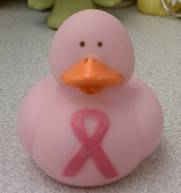AARP Hearing Center
One Down, The Rest Of My (Long) Life To Go
By Pam Evans, May 15, 2012 02:17 PM

One year ago this month, I heard the words that turned my world upside down. "You have breast cancer."
I'm not alone. At 56, the chances were already building that I would be one of the 225,000+ new cases diagnosed each year in the U.S. At age 50, the chance of a woman developing the disease before she turns 60 is 1 in 36.
Admittedly, I am one of the lucky ones; my Stage One tumor was found in a routine mammogram and after a mastectomy and chemotherapy, I've resumed a 'normal' life, including enjoying a week without a visit to a doctor or the infusion center!
Breast cancer is the most common cancer among women in the United States, other than skin cancer. It is the second leading cause of cancer death in women, after lung cancer, claiming over 39,000 lives each year. Thankfully, that number is on the decline, probably due to increased awareness, better detection and treatment options. Today, there are over 2 ½ million breast cancer survivors in the U.S. alone.
My biggest challenges now are doing the things that will give me the greatest chance of avoiding a recurrence: losing some weight, eating a healthier diet and cutting back on the Pinot Grigio! That and figuring out what to do with the wavy silver hair that's taken over my previously bald scalp. (And all those years thinking I was a blonde - thank you L'Oreal Excellence Dark Ash Blonde! )
Those are actually the easiest avoidance practices to adopt. Unfortunately, the harder, if not impossible, ones to control are the environmental factors. (This is a blog about the environment and healthy aging after all!)
Everything we put on, in and around our bodies can affect what happens inside them. From the soap & shampoo we use in the shower, the creams, cosmetics and nail polishes we put on our face and body, the plastics we pack our lunch in, the fertilizer we put on our lawn and garden and even the paint and materials we select for our home can, and do impact our health.
Now, more than ever, it's important to advocate for transparency in the market, and for the adoption of science-based rules and regulations around the chemicals in our food, cosmetics and consumer products. You don't need to be an environmental activist to appreciate the need for a healthy environment, and I encourage you to be an advocate whenever, and where you can. Become familiar with the myriad of databases available online to inform your best choices for a variety of personal, family and household items. Examples include: Environmental Working Group's selection of consumer guides, The Breast Cancer Fund Campaign for Safe Cosmetics, and HGTV's " How to Avoid Volatile Organic Compounds."
Select environmentally safe and friendly products and services whenever possible. Drive less, walk (or bike) more and recycle!
If you are, or you love, a survivor, CONGRATULATIONS! It's a sisterhood we'd rather not belong to, but we're in it now so let's do the best we can to live our longest, healthiest lives and protect the same for our daughters, granddaughters and beyond.
Photo credit: jdsmith1021 via flickr.































































